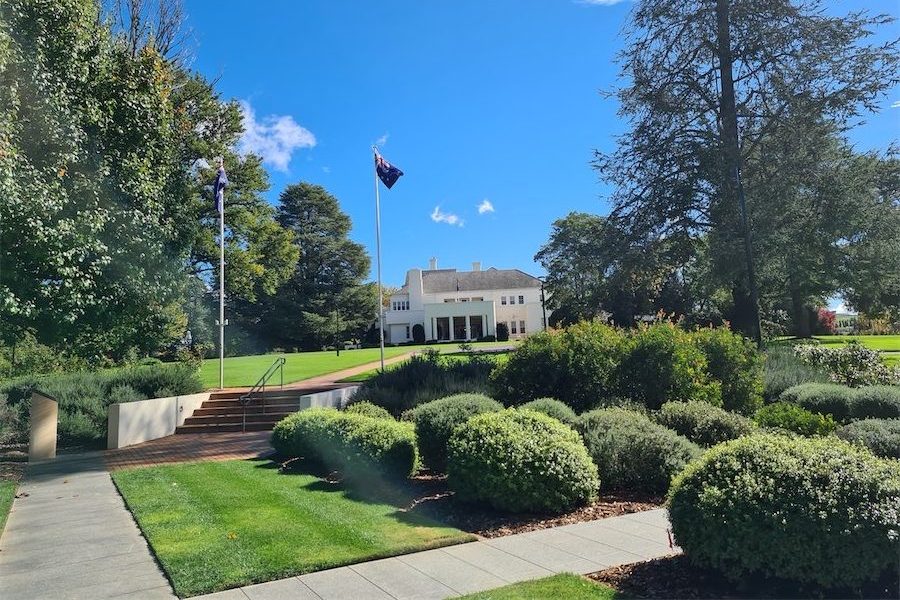
“Yesterdays” columnist NICHOLE OVERALL reveals some ghostly secrets of Blundells Cottage…
THE humble stone house perched on the edge of the national capital’s artificial lake is as much a landmark as the political and cultural institutions that dwarf it.

There, more than five decades before Canberra was made official in 1913, stands Blundells Cottage – known equally for its historic relevance and the ghost who’s said to haunt it.
Blundells Cottage is named for its longest-residing tenants rather than the Ginns who were its first, or the Oldfields as its last of long-standing.
Built by George Campbell, of the local landed gentry clan, for ploughman William Ginn. The ploughman’s brood remained on until Will himself became a landowner in 1874, which is when bullock driver George Blundell and his midwife spouse, Flora, moved in.
With Flora giving birth almost every two years, the couple needed to add to the simple dwelling to fit their eight children. The rough-hewn walls – blue, crystal-laden rock (porphyry) and sandstone quarried from Mount Majura and Black Mountain, and local slab timber – were extended, bringing it to a total of six rooms.
“Poplar Grove” – apparently its original poetic appellation – was home until George’s death in 1933, 16 years after his bride.
A shepherd and stockman with the apt surname of Oldfield came next. Harry and his wife Alice inhabited the picturesque though rudimentary property for almost 30 years. Alice, on her own for the last decade-and-a-half, took in boarders and was never seen dressed in anything but black following her husband’s passing.

In a century of occupancy, the amenities of modern life – water, gas and a sewer line – were never part of the deal. Electricity was only connected once it was repurposed as a museum in 1964.
And it was the precariousness of such conditions that led to its attached legend.
The eldest Blundell child and one of three girls, was also christened Flora for her Scottish-born mother.
There’s some familiarity with the general story: in 1892 when just 16, on a winter evening while ironing in front of the fire, Flora got too close, her nightdress erupting in flames.
The echo of her former self is said to continue to inhabit the place that was home for all of her tender years.
Shadowy appearances; items moving about; the pervasive feeling you’re not alone even if this is the case. More disturbingly, a burning smell. All these allusions to the supernatural are to be found in various sources – and occasionally acknowledged by those who believe they’ve had an encounter. [Another suggestion is a figure “all in black” within the building itself – might it be a case of mistaken identity and instead it’s the “eccentric” Alice Oldfield?]. Interestingly, the first known reports of such phenomena are as insubstantial as the ghost itself.
Perhaps though, if Flora remains tethered by her earthly bond, it has less to do with the nature of her death than her final resting place – where some also claim to have crossed her path.
Despite heavy rain, there was a large turn-out on Sunday, August 14, 128 years ago, for the teenager’s burial in the Presbyterian section of the Queanbeyan Riverside Cemetery of 1846.
Twenty-five years later, also on a rainy Sunday, her mother would be laid alongside her.
Of the other seven siblings, Charles and Herbert are there also (12 and 9 respectively at the time of Flora Jnr’s death). Husband and father, George, lies alone in the Anglican churchyard of St John’s, “in the shadow of which” he was born.
Mother and daughter’s combined burial marker is the only one of its kind of the almost 4000 within “God’s Acre” on the bank of the Queanbeyan River. In contravention of the Christian tradition in which bodies are laid with the feet pointing eastwards – in order that they might rise more easily come Judgement Day – theirs face west.
There are those pesky floods that have long disturbed the eternal slumber of many; this was the case for Charles Blundell in 1925, although his record attests to this. What’s noted in the cemetery register is that in 1981 (five years after the last major flood), remains of the Blundell women’s marble monuments were found (and are still in situ), council erecting a small headstone with plaque to replace them.
Other grave furniture has been relocated after disasters, natural and otherwise (not necessarily accompanied by the occupants), and while there are a few “out of alignment”, that of the two Floras is the only one facing “backwards”. As to the why, I’m so far, dare I say, at a dead end.
Might this then account for otherworldly restlessness?
And what of the quaint cottage to which they were so attached in life, providing as it does a “symbolic foil for the majesty of” not just the one Parliament House of 1927, but since 1988, two?
Almost as disturbing as the tales of Flora’s ghost, after the final exit of the more corporeal residents, it was to make way for a lake to be named for the capital’s creator.
Fortunately, the house survived to become a bastion of the region’s historic record; its shutterless windows unblinking eyes continuing to overlook a modern city that’s grown up and around it.
Though small in stature, more than 160 years on, the spirit of Blundells Cottage is undiminished – in all manner of speaking.
Who can be trusted?
In a world of spin and confusion, there’s never been a more important time to support independent journalism in Canberra.
If you trust our work online and want to enforce the power of independent voices, I invite you to make a small contribution.
Every dollar of support is invested back into our journalism to help keep citynews.com.au strong and free.
Thank you,
Ian Meikle, editor




Leave a Reply